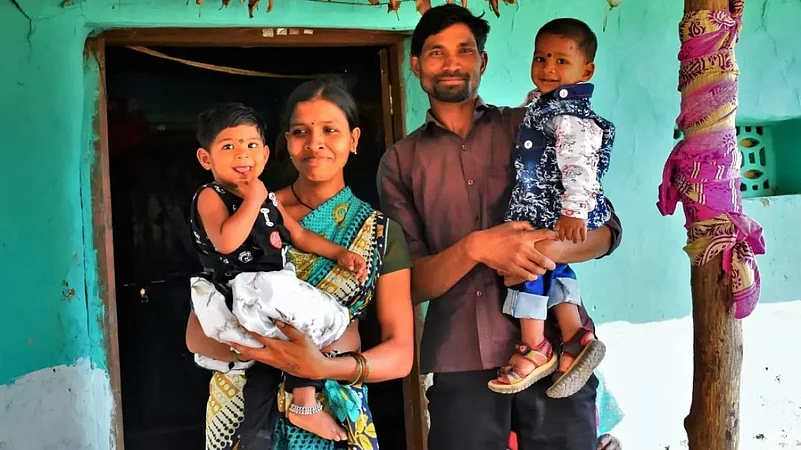"Familial relationships may take the form of domestic, unmarried partnerships or queer relationships", the Supreme Court has observed, while noting that an ''atypical" manifestation of a family unit is as real as its traditional counterpart and deserves protection under the law.
The predominant understanding of the concept of a "family" both in the law and in society is that ''it consists of a single, unchanging unit with a mother and a father (who remain constant over time) and their children.
"This assumption ignores both, the many circumstances which may lead to a change in one's familial structure, and the fact that many families do not conform to this expectation to begin with. Familial relationships may take the form of domestic, unmarried partnerships or queer relationships," a bench of Justices DY Chandrachud and AS Bopanna said in an order uploaded on Sunday.
The observations are significant as activists have been raising the issue of recognising LGBT marriages and civil unions as well as allowing live-in couples to adopt after the apex court decriminalised homosexuality in 2018.
The bench said that a household may be a single parent household for any number of reasons, including the death of a spouse, separation, or divorce. "Similarly, the guardians and caretakers (who traditionally occupy the roles of the "mother" and the "father") of children may change with remarriage, adoption, or fostering,'' it said.
It said that these manifestations of love and families may not be typical but they are as real as their traditional counterparts and such atypical manifestations of the family unit are equally deserving not only of protection under the law but also of the benefits available under social welfare legislation.
"The black letter of the law must not be relied upon to disadvantage families which are different from traditional ones. The same undoubtedly holds true for women who take on the role of motherhood in ways that may not find a place in the popular imagination," said Justice Chandrachud who penned down the verdict on behalf of the bench.
The top court made the observation in a verdict while holding that a working woman cannot be denied her statutory right to maternity leave for her biological child only because her husband has two children from a previous marriage and she had availed the leave to take care of one of them.
The bench said that unless a purposive interpretation were to be adopted in the present case, the object and intent of the grant of maternity leave would simply be defeated.
"The grant of maternity leave under Rules of 1972 is intended to facilitate the continuance of women in the workplace. It is a harsh reality that for such provisions, many women would be compelled by social circumstances to give up work on the birth of a child, if they are not granted leave and other facilitative measures" it said.
It added that no employer can perceive childbirth as detracting from the purpose of employment and childbirth has to be construed in the context of employment as a natural incident of life and hence, the provisions for maternity leave must be construed in that perspective.
It said that the facts of the present case indicate that the spouse of the appellant (a nurse by profession) had a prior marriage that had ended as a result of the death of his wife after which she married him.
"The fact that the appellant's spouse had two biological children from his first marriage would not impinge upon the entitlement of the appellant to avail maternity leave for her sole biological child.
"The fact that she was granted child care leave in respect of the two biological children born to her spouse from an earlier marriage may be a matter on which a compassionate view was taken by the authorities at the relevant time", it said.
The bench said that gendered roles assigned to women and societal expectations mean that women are always pressed upon to take a disproportionate burden of childcare work.
It referred to a 'time-use' survey conducted by the Organisation for Economic Co-operation and Development (OECD) and stated that women in India currently spend up to 352 minutes per day on unpaid work, 577 per cent more than the time spent by men and time spent in unpaid work includes childcare.
"In this context, the support of care work through benefits such as maternity leave, paternity leave, or child care leave (availed by both parents) by the state and other employers’ is essential.
"Although certain provisions of the Rules of 1972 have enabled women to enter the paid workforce, women continue to bear the primary responsibility for child care. The grant of child care leave to the appellant cannot be used to disentitle her to maternity leave under Rule 43 of the Rules of 1972", it said.
The top court said that the facts of the present case, too, indicate that the structure of the appellant’s family changed when she took on a parental role with respect to her spouse’s biological children from his previous marriage.
"When the appellant applied to PGIMER for maternity leave, PGIMER was faced with facts that the law may not have envisaged or adequately accounted for. When courts are confronted with such situations, they would do well to attempt to give effect to the purpose of the law in question rather than to prevent its application", the bench said and set aside the Punjab and Haryana High Court order.
(With PTI inputs)
















